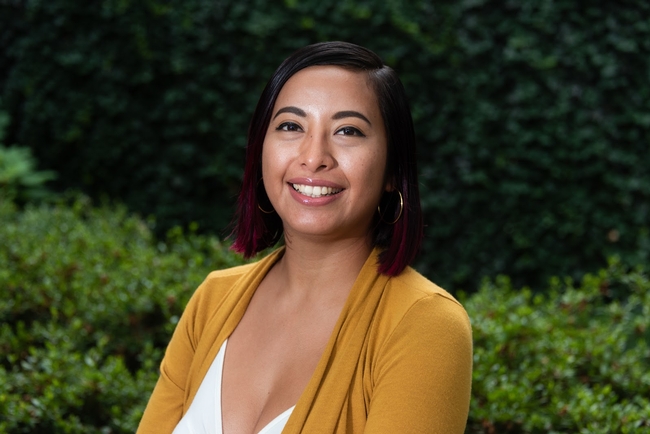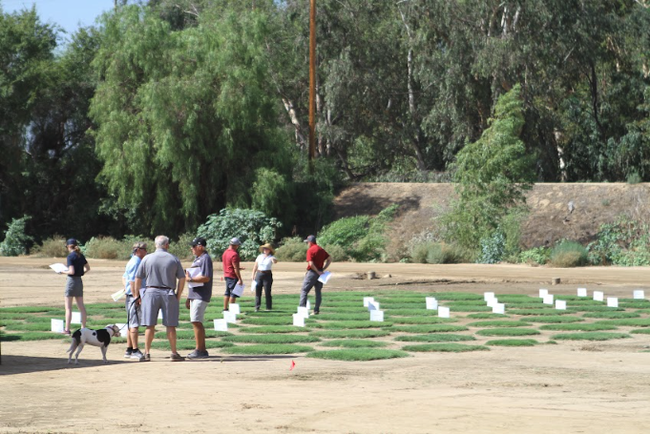- Author: Katherine Webb-Martinez
The new UC ANR Programmatic Footprint Maps illustrate the locations of UC Cooperative Extension advisors, UCCE specialists, other UCCE academics, and community educators by program areas. They also show UCCE advisor and specialist positions that are under recruitment.
This tool was formally released during the UC ANR Town Hall on Sept. 15. This tool had a soft launch in the fall of 2021 to serve as a resource during the 2021 UCCE position call process. It now has its own webpage, improved instructions and several other enhancements thanks to feedback from UCCE academic users, Program Council, Government Relations, Strategic Communications and Development Services.
UC ANR Programmatic Footprint Maps
Where are the maps?
The link to this map tool and the informational web page can be found at https://ucanr.edu/sites/ANR_Footprint and under the UC ANR website's “People” tab.
Who works on what?
This tool was designed primarily for members of the UC ANR network to find out who we have working in key program areas and where they are across the state. You can find colleagues working on similar projects who you might not already know. With our great fortune to be hiring so many new people, we imagine this tool will be particularly helpful for new colleagues.
The information also can illuminate gaps and needs to inform UCCE position proposal development and future hiring.
Updating display data
UCCE academics can quickly change which program maps and counties they appear on in Project Board. The updates will appear on the maps the following day. More how-to information is on the “Help” web page.
Community educators can make adjustments to their selections, and thus how they display on the maps, through the condition-change full-time equivalent survey sent annually in June or July.
Please take moment to update or improve your ANR Directory information, some of which displays on these maps. Specifically, make sure your title is descriptive and that you have added a primary discipline and specialty information (e.g. organic/regenerative agriculture, small farms, wildfire, etc.) See the “Update Your Profile” web page.
- Author: Pamela Kan-Rice
Nearly 170 turfgrass professionals, academics and scientists met at the Turfgrass & Landscape Research Field Day at the UC Riverside Agricultural Operations Research Station to learn about the latest research on turfgrass on Sept. 15.
Topics included drought management, drought-tolerant species and cultivars, weed control, salinity management, reclaimed water use and more.
New drought-tolerant cultivars that better retain green color during winter – UCR 17-8 and UCR TP6-3 – developed by UC Riverside's Turfgrass Breeding team were featured. Fifteen exhibitors showcased their services from irrigation supplies to fertilizer to seeds.
“This grass we're about to release — they meet the state's water requirements,” Jim Baird, UC Cooperative Extension turfgrass specialist, told the Los Angeles Times, which referred to Baird as “the state's Mark Twain of turf. Our LeBron of lawns. The Ira Glass … of grass.”
The new cultivars use about half as much water as most Southern California lawns and are soft to touch.
Participants visited bermudagrass demonstration plots and discussed them with the researchers.
“There are 24 bermudagrass hybrids developed by our breeding team and six commercially available cultivars as checks – ‘Bandera', ‘Bullseye', ‘Celebration', ‘Midiron', ‘Santa Ana' and ‘Tifway II',” said Marta Pudzianowska, UC Riverside postdoc researcher.
The Turfgrass & Landscape Research Field Day is held every year in September. More information about the 2023 event is online at https://ucanr.edu/sites/turfgrassfieldday.
- Author: Pamela Kan-Rice
The Informatics and GIS (IGIS) Statewide Program has announced their fall 2022 workshop schedule.
All workshops will be on Zoom and are free for the UC ANR community.
Workshops include
- Introduction to ArcGIS Online – Fri 9/30 1-4 p.m.
- Intro to R 3-part series – Part 1 Tues 10/11, 3:30-5 p.m.; Part 2 Wed 10/12, 3:30-5 p.m.; Part 3 Fri 10/14, 10:30 a.m.-12 p.m.
- Introduction to ArcGIS Pro – Fri 10/21, 1-4 p.m.
- Introduction to ArcGIS Field Maps – Fri 11/18, 1-4 p.m.
- Computing Agroclimate Metrics in R – Fri 12/2, 11 a.m.-12:30 p.m.
- Introduction to ArcGIS Story Maps – Fri 12/9, 1-4 p.m.
For details about these workshops, see the IGIS website.
For more information about all the IGIS workshops, visit https://ucanr.edu/blogs/blogcore/postdetail.cfm?postnum=55209.
- Author: Pamela Kan-Rice
Hispanic Heritage Month began on Sept. 15 and continues through Oct. 15.
October Hispanic Heritage Month events will be in Spanish and will take place via Facebook Live. Follow UC ANR en Español on Facebook. 
Wednesday, Oct. 5, 1 – 2 p.m.:
Susana L. Matias Medrano: Healthy living
Susana L. Matias Medrano, Ph.D., UC Cooperative Extension specialist in the Department of Nutritional Sciences & Toxicology at Berkeley, will lead a discussion of healthy living, including considerations around obesity and breastfeeding. Susana's research interests include maternal and child nutrition, immigrant health, food security, obesity and diabetes prevention, nutritional and behavioral interventions, and evaluation research.
Wednesday, Oct. 12, 1 – 2 p.m.:

UC ANR Global Food Initiative Fellow and UC Riverside doctoral candidate Magda Argueta will discuss her research around ancient Mayan pollinating practices with stingless bees.
Thursday, Oct. 13, 1 – 2 p.m.:
Samuel Sandoval Solis: Climate change effects

For more Spanish-language Hispanic Heritage Month content, including a special Latino playlist, Latino movie recommendations and museum exhibits, visit ANR's Hispanic Heritage Month webpage. If you have questions, contact Ricardo Vela at rvela@ucanr.edu.
The purpose of the celebration is to recognize the contributions and vital presence of Hispanics and Latin Americans in the United States.
- Author: Pamela Kan-Rice

McCorkle, who was born in Gilroy, is known for guiding the rapid expansion of both UC Davis and the University of California system in the 1950s through the 1970s with UC President Charles Hitch and UC Davis Chancellors Emil Mrak and James Meyer.
McCorkle returned from service in the Marines during World War II to complete his bachelor's and master's degrees at UC Berkeley in agricultural economics. His first job out of college was in the crop and livestock loan department at Bank of America, which allowed him to work while earning his Ph.D. at UC Berkeley.
After serving a year in the Marines during the Korean War, McCorkle began his UC career in 1952 as an assistant professor in the new agricultural economics department at the University Farm, which would become UC Davis in 1959. He became vice chancellor as the campus began to grow.
“Those were exciting times to be on this campus,” McCorkle said in a 1998 interview. “We were at about 2,500 or 3,000 students I guess when I came in, and in a very short time we were at 12,500.”
In 1969, he was appointed UC Davis dean of the College of Agricultural and Environmental Sciences. In 1970, McCorkle was appointed senior vice president of the University of California system, second only to the UC president, overseeing the university statewide.
While McCorkle was the dean at UC Davis, “He was instrumental in getting UC involved in the California Agricultural Leadership Program,” said Alex McCalla, UC Davis professor emeritus.
After McCorkle left UC Davis to join UC Office of the President, McCalla succeeded McCorkle as UC Davis dean of the College of Agricultural and Environmental Sciences and followed up on the California Agricultural Leadership Program by joining the Deans Council with his counterparts at Cal Poly San Luis Obispo, Cal Poly Pomona and Fresno State to determine which topics would be taught by each campus for the prestigious program, which recently announced its 52nd class.
McCorkle returned to teaching at UC Davis in 1978. He decided his graduate students, many who didn't grow up on farms, needed exposure to California agriculture.
“Chet was instrumental in securing the Liquid Sugars endowment, which funds field study trips for graduate students in agricultural and resource economics to learn more about California agriculture,” said Rachael Goodhue, UC Davis chair and professor in the Department of Agricultural and Resource Economics, who now oversees the activities.
“Chet was very well connected with the ag industry; he was not interested in publishing erudite articles in academic journals,” said McCalla, who was also McCorkle's neighbor for eight years.
McCorkle took early retirement from UC in 1991, then was appointed by President George H.W. Bush to a commission to review the former Soviet Union's food sector to guide modernization of the new Russian Republic's agricultural economy.
Over his career, he authored three books and more than 100 scientific and technical articles.
In 2008, the College of Agricultural and Environmental Sciences at UC Davis honored him with an Award of Distinction for helping “generations of Californians stay on top of business trends and maintain a competitive edge in the global marketplace.”
In 2019, he authored his final case study for the California Agribusiness Executive Seminar, a short course for agriculture leaders, which he co-founded in 1989 with Bill Henderson of Wells Fargo Bank and directed for 30 years.
Among other accomplishments, McCorkle played the trumpet, keyboard and vibes and led a jazz ensemble in Davis. He performed at Bohemian Grove well into his 90s.
McCorkle is survived by his wife, Sandy, of St. Helena; daughter Sandy of San Jose; sons Ken (Connie) of Aiken, South Carolina, and Tim (Sally) of Franklin, Tennessee; five grandchildren; 14 great-grandchildren; a stepdaughter and stepson, according to the Davis Enterprise.




